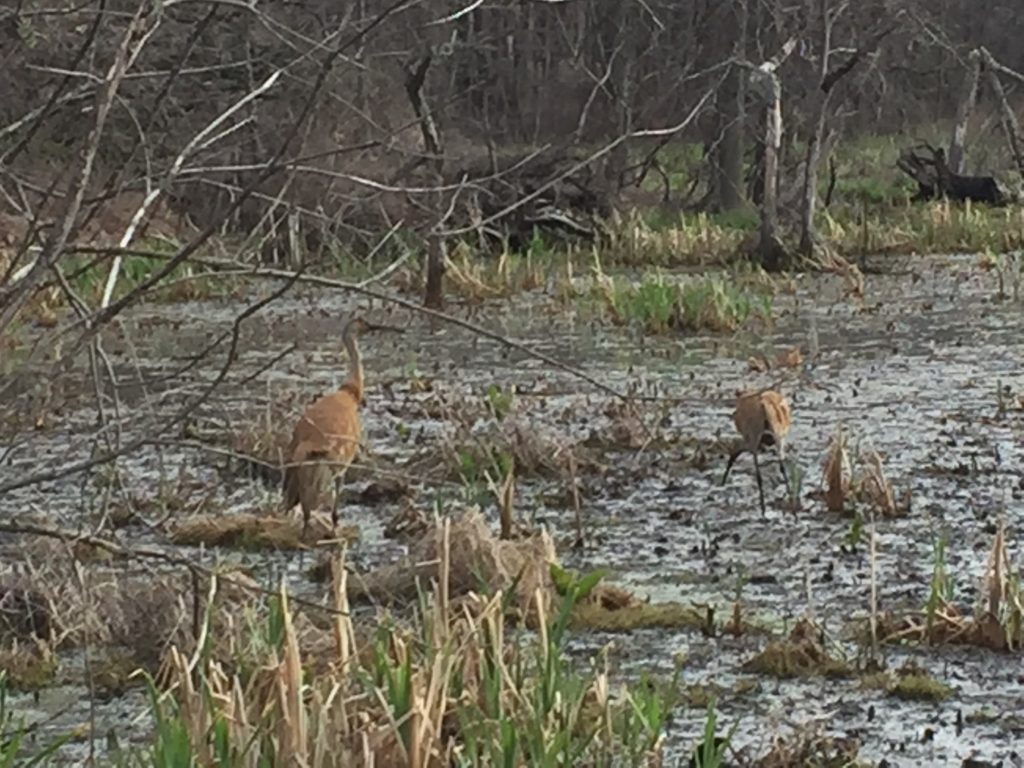 Cowles Bog is not an Illinois Nature Preserve. Neither was The Nature Conservancy involved in its protection. Nonetheless, this National Natural Landmark provides a direct connection to George Fell.
Cowles Bog is not an Illinois Nature Preserve. Neither was The Nature Conservancy involved in its protection. Nonetheless, this National Natural Landmark provides a direct connection to George Fell.
Cowles Bog is a 205-acre area within the Indiana Dunes National Lakeshore. Historically, it was part of a much larger wetland complex known as the Great Marsh, which in turn was part of an even larger complex of dune and swale habitat unique to the southern shore of Lake Michigan.
 Like the rest of the Great Marsh, Cowles Bog is more accurately described as a wetland complex, comprised of conifer swamp, wet prairie, fen, sedge meadow, marsh, and, yes, bog. This morning, it is ablaze with marsh marigolds, accompanied by the clarion call of sandhill cranes, among the oldest bird species on earth.
Like the rest of the Great Marsh, Cowles Bog is more accurately described as a wetland complex, comprised of conifer swamp, wet prairie, fen, sedge meadow, marsh, and, yes, bog. This morning, it is ablaze with marsh marigolds, accompanied by the clarion call of sandhill cranes, among the oldest bird species on earth.
 Cowles Bog apparently derived its name courtesy of a student of Henry Chandler Cowles. Famous for his field trip excursions, Cowles taught at the University of Chicago for more than 35 years. A pioneer in advancing the field of ecology as an accepted discipline within the natural sciences, he was particularly enamored of the Indiana dunes, a living laboratory for discerning how ecological communities change and evolve over time.
Cowles Bog apparently derived its name courtesy of a student of Henry Chandler Cowles. Famous for his field trip excursions, Cowles taught at the University of Chicago for more than 35 years. A pioneer in advancing the field of ecology as an accepted discipline within the natural sciences, he was particularly enamored of the Indiana dunes, a living laboratory for discerning how ecological communities change and evolve over time.
 Among Cowles’ students was Victor Ernest Shelford, who, under Cowles’ influence, evolved from a classical zoologist into an animal ecologist. Rather than studying animals independent of their environments, he significantly advanced the understanding of plants and animals being dynamically and inextricably linked as a single community (or biome, to use the technical term.)
Among Cowles’ students was Victor Ernest Shelford, who, under Cowles’ influence, evolved from a classical zoologist into an animal ecologist. Rather than studying animals independent of their environments, he significantly advanced the understanding of plants and animals being dynamically and inextricably linked as a single community (or biome, to use the technical term.)
Shelford, who spent his entire teaching career at the University of Illinois, stood out from his peers for being activist-minded. Unlike most academics of his time, he was adamant about using scientific knowledge to actually protect natural lands. Accordingly, he founded the Ecological Society of America to do just that. But when his fellow academics grew uneasy with Shelford’s activist agenda, he used his own money to start up a splinter group, the Ecologists’ Union.
 George Fell took only one course under Shelford, and apparently didn’t like his professor much. At least at first. Years later, Fell would be elected to the board of the Ecologists’ Union and become the driving force in transforming it into The Nature Conservancy.
George Fell took only one course under Shelford, and apparently didn’t like his professor much. At least at first. Years later, Fell would be elected to the board of the Ecologists’ Union and become the driving force in transforming it into The Nature Conservancy.
The start-up years of TNC were — to put it politely — dynamic. Big, competing ideas among super smart, exceptionally strong-willed individuals. (Shameless plug alert: I chronicle the necessary sausage making in detail in Force of Nature.)
But when I stroll through Cowles Bog, I think not of the many battles George fought in starting up TNC, the Illinois Nature Preserves Commission, and, in sum, the entire Natural Areas Movement. Rather, I marvel just how interconnected everything is. The many people — yesterday, today and tomorrow — who protect such places as Cowles Bog. And the many different kinds of plants and animals that make such places such as Cowles Bog one of sheer beauty, awe and inspiration.


One thought on “Cowles Bog”